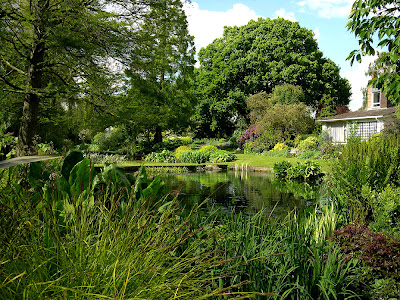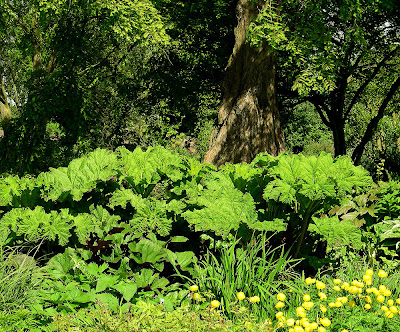The garden of Beth Chatto is among the most famous gardens of Great Britain.
 She started to build it in the 1960’s with his husband Andrew Chatto in a section of their orchard where the bad conditions did not allow any agricultural activity. However, Andrew Chatto was an enthusiastic follower of the German horticultural movement led by Karl Foerster that strived after shaping gardens the closest possible to nature. Based on a very thorough knowledge of the needs and faculties of plants, they created associations of plants that proved viable in the given environment.
She started to build it in the 1960’s with his husband Andrew Chatto in a section of their orchard where the bad conditions did not allow any agricultural activity. However, Andrew Chatto was an enthusiastic follower of the German horticultural movement led by Karl Foerster that strived after shaping gardens the closest possible to nature. Based on a very thorough knowledge of the needs and faculties of plants, they created associations of plants that proved viable in the given environment.
 Besides, Chatto paid much attention to the forms of growth of plants and to the colors and textures of leaves, and based his harmonious compositions on their contrasts. The result is just fascinating. The plants that grow in habitats suitable to their own needs are vigorous and require few care. The compositions are so refined that one can never get tired of watching them. The garden is marvelous all around the year.
Besides, Chatto paid much attention to the forms of growth of plants and to the colors and textures of leaves, and based his harmonious compositions on their contrasts. The result is just fascinating. The plants that grow in habitats suitable to their own needs are vigorous and require few care. The compositions are so refined that one can never get tired of watching them. The garden is marvelous all around the year.
 I was there in May 2005, in a period that is not really interesting from horticultural point of view – but it was touchingly beautiful. And not only to me. As a psychologist, I was particularly happy to see how much this garden soothed the visitors and how much it lifted up their hearts. In 2005 I realized the great transformation of our own garden on the basis of the lessons learned there. The results are already visible. Even in very hard places I managed to create associations that are easy to care and are beautiful all around the year.
I was there in May 2005, in a period that is not really interesting from horticultural point of view – but it was touchingly beautiful. And not only to me. As a psychologist, I was particularly happy to see how much this garden soothed the visitors and how much it lifted up their hearts. In 2005 I realized the great transformation of our own garden on the basis of the lessons learned there. The results are already visible. Even in very hard places I managed to create associations that are easy to care and are beautiful all around the year.
 On Hortus Carmeli you can see eighty more photos on the garden of Beth Chatto.
On Hortus Carmeli you can see eighty more photos on the garden of Beth Chatto.
 She started to build it in the 1960’s with his husband Andrew Chatto in a section of their orchard where the bad conditions did not allow any agricultural activity. However, Andrew Chatto was an enthusiastic follower of the German horticultural movement led by Karl Foerster that strived after shaping gardens the closest possible to nature. Based on a very thorough knowledge of the needs and faculties of plants, they created associations of plants that proved viable in the given environment.
She started to build it in the 1960’s with his husband Andrew Chatto in a section of their orchard where the bad conditions did not allow any agricultural activity. However, Andrew Chatto was an enthusiastic follower of the German horticultural movement led by Karl Foerster that strived after shaping gardens the closest possible to nature. Based on a very thorough knowledge of the needs and faculties of plants, they created associations of plants that proved viable in the given environment. Besides, Chatto paid much attention to the forms of growth of plants and to the colors and textures of leaves, and based his harmonious compositions on their contrasts. The result is just fascinating. The plants that grow in habitats suitable to their own needs are vigorous and require few care. The compositions are so refined that one can never get tired of watching them. The garden is marvelous all around the year.
Besides, Chatto paid much attention to the forms of growth of plants and to the colors and textures of leaves, and based his harmonious compositions on their contrasts. The result is just fascinating. The plants that grow in habitats suitable to their own needs are vigorous and require few care. The compositions are so refined that one can never get tired of watching them. The garden is marvelous all around the year. I was there in May 2005, in a period that is not really interesting from horticultural point of view – but it was touchingly beautiful. And not only to me. As a psychologist, I was particularly happy to see how much this garden soothed the visitors and how much it lifted up their hearts. In 2005 I realized the great transformation of our own garden on the basis of the lessons learned there. The results are already visible. Even in very hard places I managed to create associations that are easy to care and are beautiful all around the year.
I was there in May 2005, in a period that is not really interesting from horticultural point of view – but it was touchingly beautiful. And not only to me. As a psychologist, I was particularly happy to see how much this garden soothed the visitors and how much it lifted up their hearts. In 2005 I realized the great transformation of our own garden on the basis of the lessons learned there. The results are already visible. Even in very hard places I managed to create associations that are easy to care and are beautiful all around the year. On Hortus Carmeli you can see eighty more photos on the garden of Beth Chatto.
On Hortus Carmeli you can see eighty more photos on the garden of Beth Chatto.
No comments:
Post a Comment